June 29, 2007
Air Date: June 29, 2007
FULL SHOW
SEGMENTS
Energy Independence Day
/ Jeff YoungView the page for this story
An energy bill before Congress could dramatically shift the U.S. toward efficiency and cleaner fuels. Or, it could do very little to reduce imported oil and global warming pollution. Living on Earth's Washington correspondent Jeff Young tells us it all depends on the long hot summer of energy debate. (06:30)
Moving Beyond Denial
View the page for this story
A leading magazine of conservative thought just published a cover article arguing that conservatives should accept the science of climate change and move on to figure out what to do about the problem. Host Steve Curwood talks with Jim Manzi, author of “Game Plan: A Conservative Strategy on Global Warming” in the latest issue of the National Review. (06:00)
New Orleans Flood Risk and Racial Disparity
View the page for this story
This hurricane season, some residents of New Orleans are feeling a little safer than they did in the aftermath of Hurricane Katrina. New maps released by the Army Corps of Engineers show how recent work has reduced the flood risk in some neighborhoods. But environmental justice activists say the maps show that not all neighborhoods have been treated equally. Host Steve Curwood talks with Nathalie Walker of Advocates for Environmental Human Rights, in New Orleans, and then turns to Colonel David Berszeck of the Army Corps of Engineers. (08:15)
The Right to Know: Irradiated Food Labels
View the page for this story
Irradiating fruits, vegetables and meats with as much as 15 million times the energy of a single chest X-ray kills disease-causing germs and extends the shelf life of foods. But is irradiation safe and should consumers know when their food is treated? Living on Earth host Steve Curwood discusses the issue with Dr. Urvashi Rangan, a health scientist and policy analyst at Consumers Union. (08:00)
Note on Emerging Science
/ Amy FishView the page for this story
Scientists have figured out how to turn heat into a sound wave that will generate electricity. Amy Fish reports. (01:30)
Making Room for Shorebirds
/ Deborah WangView the page for this story
Where rivers meet the sea, shorebirds flock to marshes. But many former marshes have become fertile farmland. Now some farmers in Washington State's Skagit River Valley are working with conservationists and flooding part of their fields to find out if the disappeared shorebirds will return. Deborah Wang of KUOW reports. (05:30)
Plastic, Plastic Everywhere
View the page for this story
Captain Charles Moore is one of a growing number of researchers who are alarmed at how much plastic is littering our oceans. Moore tells Living on Earth’s Ingrid Lobet that he’s not only concerned about large pieces of plastic; it’s the microscopic bits that are problematic, as well. (05:30)
Hoo’s Calling
View the page for this story
Owls and other birds are just a phone call away, thanks to Dr. Dale Joachim. The MIT professor created a technology to monitor birds remotely via cellphones so that researchers can get a count of the animals without disturbing their habitats. IEEE Spectrums Willie D. Jones reports. (05:30)
This week's EarthEar selection
listen /
download
Screams of the Eastern Screech Owl.
Show Credits and Funders
Show Transcript
HOST: Steve Curwood
GUESTS: Jim Manzi, Nathalie Walker, Lieutenant Colonel David Berszeck, Dr. Urvashi Rangan
REPORTERS: Jeff Young, Deborah Wang, Willie D. Jones
[THEME]
CURWOOD: From Public Radio International - this is Living on Earth.
[THEME]
CURWOOD: I’m Steve Curwood
The Food and Drug Administration wants to relax the rules that require the labeling of irradiated food. But the move is coming under fire from those who say consumers should know what they are getting. In some cases, irradiation can encourage sloppy food processing.
RANGAN: The fact of the matter is that at the processing plant if that meat is so dirty that it doesn’t pass USDA inspection standards, you can hold the meat, irradiate it and then sell it to consumers.
CURWOOD: Also charges that the Army Corps of Engineers is racially biased in the rebuilding of flood protection systems in New Orleans.
WALKER: When you look at these maps and see where do we have any significant reduction of floodwater and it’s always in the white neighborhoods.
CURWOOD: Those stories and more this week on Living on Earth, stick around.
[NPR NEWS CAST]
ANNOUNCER: Support for Living on Earth comes from the National Science Foundation and Stonyfield Farm.
[THEME RETURN]
Energy Independence Day
CURWOOD: From the Jennifer and Ted Stanley Studios in Somerville, Massachusetts - this is Living on Earth. I’m Steve Curwood.
A bill with the potential to make a dramatic shift in U.S. energy policy is making its way through Congress. Democratic leaders say they want to declare “energy independence” by July 4, with a package that supports clean energy and reduces oil imports. But as Living on Earth’s Jeff Young reports, there’s a long hot summer of difficult debate that’s still ahead.
YOUNG: House Speaker Nancy Pelosi is taking full advantage of the July 4 symbolism to promote the democrats’ energy legislation. She stood under a portrait of George Washington during a Capitol Hill press conference about what she called energy independence.
PELOSI: Today, in the tradition of our founding fathers and in the interest of our children and our grandchildren we begin a new American revolution.
YOUNG: The package of bills democrats propose would repeal about 16 billion dollars in tax breaks for oil companies and redirect much of it to alternative and renewable sources for electricity and more biofuels for transportation. And while the bills do not regulate greenhouse gas emissions, Pelosi claims the measures would help combat climate change. The measure’s energy efficiency standards alone could reduce carbon dioxide emissions by more than 8 billion tons over the next two decades—that’s about as much as is produced by all the cars on the road today in a year. But Pelosi’s energy revolution is already taking fire from both flanks. Republicans say the proposals would produce little to meet growing energy demands.
SHIMKUS: That’s what this bill was all about--energy independence by the fourth of July. This bill does zippo.
YOUNG: That’s Illinois Republican John Shimkus, who wanted more emphasis on nuclear power and support for a liquid transportation fuel made from coal. And there are divisions within the democratic ranks as well. Some are disappointed that the House bills avoid two of the biggest energy issues: requirements for more renewable sources of electricity and higher fuel economy standards for autos. Ed Markey of Massachusetts wants to amend the bill to make cars and trucks get 35 miles per gallon, that’s in line with what the Senate recently approved.
MARKEY: The public wants to know if we democrats are ready to approach our energy threats any differently than republicans did during the 12 years they controlled this congress. And this issue is the big missing piece.
YOUNG: Markey’s proposal to increase standards for CAFE, or corporate average fuel economy, has 140 co-sponsors—a third of all the Representatives. Nevertheless, a fellow Democrat House Energy Committee Chairman, John Dingell of Michigan, refused to allow the amendment.
DINGELL: The chair recognizes that the bills we are working on may have displeased some of our more ideologically inclined colleagues on the left and on the right. We are proceeding on legislation where there is consensus. We will need to get beyond the stale debate on miles per gallon and CAFE.
YOUNG: Dingell’s critics accuse him of avoiding fuel economy requirements in order to protect his home state auto industry. This radio ad by the liberal group Move On calls Dingell a dinosaur.
[AD SOUND]
FATHER: A Dingellsaurus. Someone who’s been in Congress so long, he forgets about the people who sent him there.
BOY: Is a Dingellsaurus dangerous?
FATHER: Yeah, very. Because if the Dingellsaurus gets his way, we all could be extinct.
YOUNG: Dingell says he plans to deal with auto efficiency in the fall, when his energy committee drafts comprehensive climate change legislation. Another sore point for some democrats is the lack of a renewable electricity standard. That would require electric utilities to use more renewable sources like wind and solar. The Senate had approved such a measure in past years, but this year it ran into unexpected opposition. New Mexico Democratic Senator Jeff Bingaman, a renewable energy booster, says he thinks he knows why. Bingaman says some Senators may have voted for solar and wind in earlier years knowing such a measure would fail in the House.
BINGAMAN: Senators that opposed it realized that if we were able to pass it through the Senate this time it might actually become law. Whereas before it was not that big a concern with the House in Republican hands.
YOUNG: The renewable energy and auto fuel efficiency standards could still come up as amendments when the energy debate hits the House floor, likely in mid-July. If the bills pass, another fight is looming with the White House. President Bush has threatened to veto the Democrats energy package. But that’s not causing Democratic Senate leader Harry Reid to back down.
REID: I don’t know what they have down there I guess it’s a big rubber stamp, ‘veto.’ So they can take their rubber stamp and you know what they can do with it.
YOUNG: With a veto showdown and Democratic infighting, it looks like this energy Independence Day is sure to set off some political fireworks.
For Living on Earth I’m Jeff Young in Washington.
[The Beastie Boys “Electric Worm” from ‘The Mix-Up’ (Capitol Records – 2007)]
Related links:
- Explanation of legislation from House Energy Committee
- Rep. Ed Markey (D-MA) on his fuel economy standards proposal
- An explanation of Renewable Electricity (or Portfolio) Standards
Moving Beyond Denial
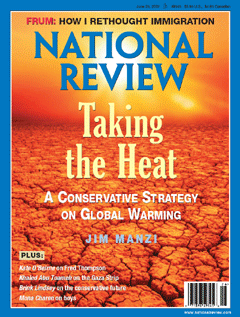
Cover from the June 25, 2007 issue. (Courtesy of National Review)
CURWOOD: The prospects for comprehensive federal legislation to combat climate change got a boost recently when republican senator John Warner of Virginia joined the longtime bipartisan efforts of Senator Joe Lieberman of Connecticut. Warner is one of the most powerful republicans in the Senate, and his endorsement of a cap-and-trade system to limit carbon emissions is the latest sign of a significant shift among those on the right when it comes to the climate issue. The National Review has also jumped on the bandwagon. This leading journal of conservative intellectual thought is running a cover story urging conservatives to drop their skepticism of climate change and start figuring out what to do about it. Software executive Jim Manzi wrote the article. He says it’s time for a change.
MANZI: I believe that it is no longer possible either scientifically or politically to deny the science of global warming that makes specific claims, namely that it’s very likely that human activity has increased global temperatures. And by extension that’s likely to happen in the future. And I think conservatives have really painted themselves into a corner by trying to deny that science and it would be better for everyone if we could accept the science and move on to the question of what to do about it.
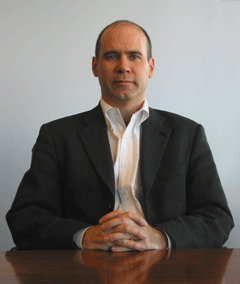
National Review contributor Jim Manzi (Courtesy of Jim Manzi)
CURWOOD: Now, the record would show that a number of conservatives were involved with what’s sometimes called a deliberate campaign of misinformation about the science around climate change. Why did conservatives get in to something which really clearly misstates the science, a disinformation campaign if you will?
MANZI: It’s my view that the best progress will be made here by not assuming malevolent motivation on any side of the this debate. I think conservatives reasonably viewed the likely policy implication of accepting the reality of global warming as being a major power grab to exert government control over the economy. They resisted accepting the scientific premise that global warming is real. And, I think that in retrospect that was a mistake. I think that game is just about up. And conservatives now find themselves walking unprepared into the middle of a very sophisticated scientific and economic conversation about how to deal with the problem.
CURWOOD: What should conservatives do now about climate change? The public basically distrusts the conservative point of view on this because of its assault on the basic science here. How can conservatives move forward with this?
MANZI: Well, I think that conservatives need to put forward a responsible political program to deal with this challenge, to view it primarily as a problem of insurance, that is insuring against the possibility that we will have very negative human implications of climate change. I think that on one hand, that strategy ought to focus on technology as opposed to taxes and I put forward a number of specific areas around prediction technology, mitigation technology and adaptation technology that I think ought to be part of any program to deal with global warming. I believe that climate change is a manageable risk not some existential crisis and the less this becomes a debate about political philosophies, and world views and so on and the more it becomes a technical discussion of how do we limit this risk and deal with any problems that occur almost at a technical level we’ll make a lot more progress.

Cover from the June 25, 2007 issue. (Courtesy of National Review)
MANZI: In general a cap-and-trade program, which is for all practical purposes like a virtual tax on carbon, is not a smart policy because the amount of emission reduction or abatement that is justified by current expectations of warming is small enough that we can much more easily address this through targeted technology changes than trying to introduce a massive, which is what this would be, re-engineering of our industrial economy to try to pull carbon emissions out.
CURWOOD: Conservation measures in other words or efficiency measures.
MANZI: Exactly.
CURWOOD: What about wind, solar, geothermal, the stuff that the (clears throat) forgive me, the Democrats talk about?
MANZI: Uh, look you know, look I went to MIT. I am in favor of science making life better. And I think that as alternative fuels become as they are over time more and more competitive with carbon-based fossil fuels essentially, we will continue to push carbon naturally out of our economy. And that’s things like wind, solar, new nuclear technology and so forth. And I think that targeted investments in those kinds of technologies help accelerate that reduction in unit cost in those alternative fuel technologies are great ideas for lots of reasons.
CURWOOD: At the end of your article, Jim, you write that “global warming can feel like a looser political issue to conservatives. One in which the only objective is to minimize both political and economic damage. But getting past denial and taking a science based approach to the issue, a clever candidate” and here you’re writing about a possible candidate for president, “a clever candidate could take a principled stand that pays major tactical dividends. Global warming could be the first wedge issue of the 21st century.” What do you mean by that?
MANZI: Well, I mean that for reasons we have been discussing, conservatives have been on the defensive on this issue and in my view by accepting the science that’s actually proven I believe that conservatives can put forward an alternative program for dealing with this challenge that is much better scope to the size and nature of the challenge. And as I put forward in this article I believe that using a technology based, low cost optimistic program for how to deal with this problem is both the better way to approach the problem objectively, and also one which is likely to be much more attractive to voters than the alternative program of restrictions on economic growth and carbon emissions for the purpose of mitigation.
CURWOOD: Jim Manzi is the author of the National Review cover story “Game Plan: A Conservative Strategy on Global Warming.” Thanks for joining us Jim.
MANZI: Thank you very much.
CURWOOD: You can find more of our interview with Jim Manzi by logging on to LOE dot org.
Related links:
- National Review
- Free Library link to Manzi’s National Review article
- Click to hear a longer version of Steve Curwood’s conversation with Jim Manzi.
New Orleans Flood Risk and Racial Disparity
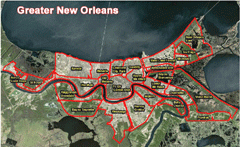
The Army Corps has run a risk assessment of future flood dangers for each neighborhood in New Orleans. (Courtesy of the Army Corps of Engineers)
CURWOOD: It’s Living on Earth. I’m Steve Curwood. It's hurricane season again, and some folks in New Orleans are feeling a little safer than they have for a while. But others feel just as vulnerable as ever. That’s because the Army Corps of Engineers has rebuilt some levees that failed in the wake of Hurricane Katrina almost two years ago. But not all neighborhoods have gotten equal treatment so far, and protection for African Americans is lagging far behind efforts for whites. The Corps of Engineers recently released maps showing its progress and the current flood risks for New Orleans’ many neighborhoods. In a few minutes, we’ll talk with one of the Corps’ managers for the project. But first, we turn to Nathalie Walker. She’s an attorney and co-director of Advocates for Environmental Human Rights, in New Orleans. Ms. Walker, hello there.
WALKER: Hello.
CURWOOD: Now when you look at the Army Corp maps as to the risk of hurricane flooding today based on their work, what do you see?
WALKER: What I see is very little improvement overall. And shockingly what I also see is that our communities of color, which in the New Orleans area are African American, are receiving totally insignificant flood reduction.
CURWOOD: So, let’s talk specifically about neighborhoods. We know about Lower Ninth Ward and New Orleans East, what kind of protection have they gotten from the Army Corp of Engineers compared say to other areas such as Lakeview, City Park?
WALKER: Well, if you take a look at Lakeview or if you look at Old Metairie, which is a suburb of New Orleans, both of those areas are getting between 4.5 to 5.5 feet of flood reduction. Which is, you know fairly significant. But when you look at New Orleans East or the Lower Ninth Ward we’re talking six inches to a foot. I mean those are areas that had 12 feet or more of water at one point after the levees broke.
CURWOOD: So, the break down here is racial you are saying?
WALKER: Well, I think so. I don’t know what other conclusion you can draw. When you look at these maps and you see, as everyone is doing, looking at the maps to see where do we have any significant reduction of floodwater, and it’s always in the white neighborhoods.
CURWOOD: Now some people look at these maps and say, “wait a second, there are some white neighborhoods that don’t get any improvement in flood protection.” I’m looking at the maps and I see particularly the area of Chalmette which is largely a white working class neighborhood doesn’t get very much protection either.

The Army Corps has run a risk assessment of future flood dangers for each neighborhood in New Orleans.
(Courtesy of the Army Corps of Engineers)
CURWOOD: Now, the Corps isn’t saying that it’s not going to help these neighborhoods that are still vulnerable. It’s just saying that it’s going to take till 2011 to get to it. What about giving the Army Corps more time?
WALKER: Oh, they can take all the time they want. But there’s no reason why they couldn’t have done significant flood reduction improvements in other areas of the city. The floodgate that they put in on the 17th Street Canal to protect the largely white area of the city wasn’t there before. So why just that neighborhood for this major undertaking? Why not any other neighborhood?
CURWOOD: There have been concerns, questions, maybe even complaints raised about how New Orleans is being redeveloped. Some people are alleging that there’s a move afoot to gentrify New Orleans.
WALKER: Absolutely, there’s simply no question about that. We had 5,000 public housing units that were occupied before Katrina. Virtually all of them have been padlocked, and that includes units that were not damaged from the flooding caused by the Corps of Engineers.
CURWOOD: Now, you say that the Army Corps of Engineers caused this flooding. What do you mean?
WALKER: People need to remember, this is so important, Katrina did not hit the city of New Orleans. It did not. And many of the people who drowned, who lost their lives were still in the city after Katrina passed. And they were celebrating on their front porches when the storm was over. And then the levees broke. It’s the Corps of Engineers that destroyed the city of New Orleans.
CURWOOD: What would you like to see the Army Corps of Engineers do differently now?
WALKER: I think they need to make it clear exactly what their plans are for installing floodgates in all of the other vulnerable areas of the city, not just the 17th Street Canal where they have installed the floodgate. All of the areas that flooded, so many of our African American neighborhoods, and we all know that’s where the flooding came from. They need to be really clear on what they’re going to do for those neighborhoods because to date, they’ve done so very little.
CURWOOD: Nathalie Walker is an attorney and co-director and founder of the Advocates for Environmental and Human Rights in New Orleans. Thank you so much.
WALKER: Thank you.
CURWOOD: Joining us now to respond to some of the concerns raised by Ms. Walker is Lieutenant Colonel David Berszeck. He's a Risk and Reliability Project Manager for the Army Corps of Engineers in New Orleans. Colonel Berszeck, Nathalie Walker says that none of the city’s African American neighborhoods have yet gotten substantial new flood protection. What is the Army Corps’ rationale for the work that's been done so far?
BERSZECK: Steve, the rationale for the work that’s been so far has been, after the storm there were a number of areas that were damaged. The first priority was to restore those areas. And that’s where the work concentrated on and focused on.
CURWOOD: You say this was just a repair but you know brand new flood gates were put in there at the 17th Street Canal. If it was all just about repairing, why did the new floodgates go in the more affluent and more white neighborhood as opposed to say New Orleans East, or other neighborhoods?
BERSZECK: Actually, Steve, that was a function of repairs. With the miles of floodwalls that exist along those three out flow canals: the 17th Street Canal, the London Avenue Canal, and the Orleans Avenue Canal. The mission was to do all the work and to do it fast. And there was no time to go ahead and look at all of those floodwalls along those canals. So the decision was made that rather than trying to bolster or improve roughly 11 to 12 miles of floodwall the decision was made to just block the surge at the mouth of the lake and just eliminate that as a threat.
CURWOOD: I’m sure though that the folks in New Orleans East or the Lower Ninth Ward would like that kind of protection. What was the process here? I mean at the end of the day, effectively none of the African American neighborhoods get substantial flood protection, certainly on the scale of what’s happened in the white neighborhoods. The accusation here is racism. The outcome seems to bare out that accusation. How was the decision made?
BERSZECK: Steve when you say outcome you’re looking at what we presently have today. And that’s not outcome. The outcome right now is that we are continuing work to meet the administration’s commitment to provide 100-year level protection to the entire system and that is work that is ongoing.
CURWOOD: Colonel Berszeck I think it’s fair to say in New Orleans some people still don’t trust the Army Corps. So, what would you say to those people to reassure them about the work the Corps is doing now?
BERSZECK: Steve, I think to reassure those people I think that you can see that we’re using the best science that’s available out there right now to go ahead and design this protection system for the future. And then we are also committed to looking to the coastal restoration solutions and look at other options and alternatives to continue to add to the protection level in the New Orleans area.
CURWOOD: Lieutenant Colonel David Berszeck is a risk and reliability project manager for the Army Corp of Engineers in New Orleans. Thank you so much for taking this time.
BERSZECK: Thank you, Steve, I appreciate being on your show.
CURWOOD: Earlier, we spoke with Nathalie Walker, of Advocates for Environmental Human Rights, also in New Orleans. For links to maps and more information about the Army Corps Flood Risk Report, check out our Web site, L-O-E-dot-org.
[Kato Hideki, Ikue Mori & Fred Frith “Loquat Tree” from ‘Death Ambient’ (Tzadik – 1995)]
Related links:
- U.S. Army Corps of Engineers Flood Maps site
- Times-Picayune Article on current New Orleans Flood Risk
- Times-Picayune Blog on Flood-Risk Assessment
CURWOOD: We’re online at L-O-E-dot-org whenever and wherever you are. You can hear the program anytime, or download a podcast. The address again L-O-E-dot-org. And we’d love to hear your comments. You can reach us at comments @ l-o-e dot org. That’s comments @ l-o-e dot O-R-G. Or you can send us a note to 20 Holland Street, Somerville, Massachusetts, 02144. Or call our listener line, at 800-218-9988. That's 800-218-99-88.
The Right to Know: Irradiated Food Labels

The international symbol of irradiation (Courtesy of U.S. Department of Agriculture)
CURWOOD: For more than 40 years, a small part of the food supply in the U.S. has been treated with powerful radiation. Irradiation can kill off dangerous microbes, extend the shelf life of foods and reduce spoilage. And by federal law, foods that have been zapped must be labeled. But public apprehension about radiation has limited the demand for food that carries the irradiated label. Now the Food and Drug Administration is proposing sweeping changes that would relax labeling requirements. We’d hoped to speak with the FDA, but officials there declined to discuss the matter until the public comment period for the new regulations ends on July 3. We turn now to Urvashi Rangan. Dr. Rangan is an environmental health scientist and policy analyst at Consumers Union, which publishes Consumer Reports magazine. She’s also Director of Greener Choices dot org. Hi there!
RANGAN: Hello, Steve.
CURWOOD: What is the current requirement for foods that are irradiated?
RANGAN: The current labeling requirement is that if a food is irradiated, then it has to be labeled as such. So whether it’s a fruit, or a vegetable, or a meat product, all foods that are irradiated are supposed to be labeled as such. I have to say in the past many years, we’ve noted foods that are irradiated and you don’t see a label on it. But that is the regulation and the requirement right now.
CURWOOD: So, what changes is the FDA proposing here and why?
RANGAN: Well the FDA, actually, has been petitioned sort of relentlessly in the past decade by people in the industry who want to use irradiation but don’t always want to label it as that. The proposed changes allow for a few things. One they would allow for food that had been irradiated not to be labeled as irradiated, especially where there’s no change in say, something like taste. The other major change would allow companies to substitute other label claims in place of irradiated.
CURWOOD: For example?
RANGAN: For example electronic pasteurization is a term that’s been proposed by the industry. They would like to use the term electronically pasteurized or cold pasteurized instead of labeling something as irradiated. Then it certainly begs the question as to why that’s happening. We know just from our recent survey in June 2007, 71 percent of consumers don’t particularly want to buy irradiated products so that can certainly lead one to believe that they’re looking for other terms maybe to hide something, maybe not.
CURWOOD: Now, to be clear irradiating food doesn’t make it radioactive, right?
RANGAN: Let’s be clear about that, that is correct. When you irradiate food it does not make it radioactive. But it is helpful to understand that for example the maximum dose of irradiation on meat is about 4.5 kiloGrays this is the unit of irradiation. And that’s equivalent to about 7 million chest X-rays. So, for a package of meat that’s a lot of energy, and a lot of X-rays to try to get these bacteria pathogens killed on the meat. The other thing though to bring up, is that in the case of meat and other irradiated products that have fat in it, that irradiation seems to cause a very unique what we call radiolytic byproduct, but it’s specific to irradiation. It changes the fat into something called 2-alkylcyclobutanones, or 2-ACBs, and those things when put into rats seem to cause cancer tumors in their colon. And, so we certainly seem to think more research needs to be done in terms of really understanding the safety of irradiation, especially when it comes to irradiating products like meat. It may also be of interest to the listeners to know that in Europe irradiating meat is illegal because of those concerns about irradiated fat.

The Radura, international symbol of irradiation(Courtesy of U.S. Department of Agriculture)
CURWOOD: So, we’ve had some tragedies around food poisoning particularly involving meat but also involving produce. To what extent would irradiating food improve consumer safety?
RANGAN: Well, we took a look at that question a few years ago at Consumer Reports and um here’s, what we found out. We actually looked at irradiated meat and tested over 800 samples of ground meat. And we found that, while irradiation certainly lowered the levels of bacteria on those products, that they didn’t always kill all of the bacteria in which case the products were probably safer, but they weren’t necessarily safe. It really comes down to understanding why we’re irradiating products in the first place and that’s to control filth. Have we taken all steps to manage the filth problem throughout the process? What we know with meat production, certainly is that it’s a very dirty process from the beginning. A number of farms simply don’t have hygiene standards to follow and that’s where these bacteria start. We think the cleaning up needs to start at the beginning and then lets see how we do at the end and what additional measures we really need to take.
It also may be of interest, and it’s a slightly unappetizing thought to know, that meat that is unfit for sale, that is so contaminated that it would be illegal to sell it, can actually be stored, irradiated and then sold to the public after that. And that’s a very big concern for us because what it does is it can mask bad hygiene problems. It can mask the fact that food was very dirty in the first place. And consumers can unknowingly buy food that was previously so contaminated that it would have been illegal to be sold.
CURWOOD: Wait a second. You’re telling me that spoiled meat can be zapped and then sold?
RANGAN: That’s right.
CURWOOD: Stuff that I would throw out of my refrigerator?
RANGAN: Stuff that you would throw out of your refrigerator. Stuff that the stores might throw out because it’s gone bad. The fact of the matter is at the processing plant if that meat is so dirty that it doesn’t pass USDA inspection standards, you can hold the meat, irradiate it, and then sell it to consumers.
CURWOOD: So, how does this stuff taste once it’s been zapped?
RANGAN: Well, when we tested irradiated beef in 2003 our taste testers found that it tasted like singed hair. And in the industry they’ve also termed it as “wet dog hair.” So, it’s rather unappetizing and it seems to be these changes in the fat specifically that seem to cause the off taste in irradiated foods with fat.
CURWOOD: And under this proposed rule change, this irradiated food could be sold to us without a label telling us it had been irradiated.
RANGAN: One of the proposals is that if there’s no change in taste that then the company could go forth and sell it without an irradiation label. And that’s simply erroneous and deceptive frankly. And it’s dependent on so many things like how much irradiation was used. And who’s tasting the stuff anyway to make that judgment call? It brings up a lot of questions as to how they would standardize something like that. And frankly we believe that it’s erroneous reasoning in terms of drawing the line between foods that should be labeled as irradiated and foods that aren’t. We think that all foods that are irradiated should be labeled as such.
CURWOOD: Urvashi Rangan is an environmental-health scientist and policy analyst at Consumers Union and Director of Greener Choices dot org.
As we mentioned earlier, the FDA refused our request for an interview to talk about its proposed labeling changes for irradiated food during a public comment period that ends on July 3. You’ll find a link to the FDA’s proposal, the Consumer Reports study, and other related resources at L-O-E dot ORG.
[Efterklang “Chapter 6” from ‘Tripper’ (The Leaf Label – 2004)]
Related links:
- Consumer Reports article about Irradiated Meat
- FDA's Proposed Rules on Irradiation
- Electronic comments can be submitted to
- More information on our food supply and green living
Note on Emerging Science
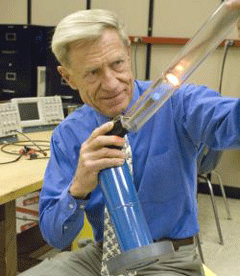
Physicist Orest Symko uses a blowtorch to heat a metallic screen inside a plastic tube. The metallic screen produces a loud tone that can be used to generate electricity. (Courtesy of University of Utah)
CURWOOD: Coming up: turtles eat it, sea birds eat it…even tiny shrimp eat it. Plastic is finding its way into every part of the marine food chain. But first this Note on Emerging Science from Amy Fish. And you’re listening to Living on Earth.
FISH: Listen up! This could be the sound of a new renewable energy source—cheap, portable, and fueled only by waste heat.
[SCIENCE NOTE THEME]
Scientists at the University of Utah start by turning the disorderly energy of heat into a pure, single-frequency sound, using a tube-shaped resonator small enough to fit in the palm of your hand. The resonator contains a stack of plates or fibers. When the tube is heated at one end, the expanding air inside diffuses toward the cold air at the other end. The movement of the air through the stack causes vibrations, which in turn produce a sound wave.

Physicist Orest Symko uses a blowtorch to heat a metallic screen inside a plastic tube. The metallic screen produces a loud tone that can be used to generate electricity. (Courtesy of University of Utah)
[SOUND]
Some versions of the resonators produce 135 decibels. That’s the noise level of a jackhammer. But don’t worry about the racket—researchers promise any sound can easily be muffled.
Once they’ve produced the sound, the Utah scientists use a long-understood phenomenon called the piezoelectric effect to turn the sound waves into electricity. Each cubic centimeter of tube produces about one watt of power.
The devices are small, durable, and cheap to produce, so they might make good portable electricity sources for outfits like the U.S. Army, which is funding the research. And scientists say they could power the process with just about any heat source, from power plant waste heat to a running computer—even the heat of sun.
So—it looks like a little hot air might be useful after all.
Related link:
More on Professor Orest Symko’s research
Making Room for Shorebirds
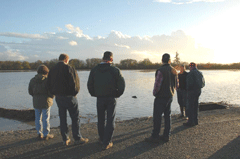
The Nature Conservancy’s Kevin Morse with Skagit County “Farmers for Wildlife” observe natural flooding of the Skagit River. (Photo: Kirsten Morse)
CURWOOD: It’s Living on Earth. I’m Steve Curwood. The number of birds has been sharply declining in the United States in recent years, and the causes are many. A lot of migrating birds collide with lit buildings at night, and many fall into the clutches of house cats on the loose. Another major problem for birds is the loss of habitat to everything from subdivisions, logging and industrial farming. But in Washington State, farmers and environmental activists are working together in a project to find ways to make more room for birds, specifically migratory shorebirds that require lush, coastal wetlands, by changing the ways that the farmers manage their land. Deborah Wang from member station KUOW in Seattle has the story.
[COW MOOING]
WANG: It’s a busy time of year for farmer Alan Messman. He’s rounding up the last of the cattle to put out on his fields, which are now thick with new grass.
MESSMAN: There are several steers here, three or four, I know there’s one big one over in this bin too.
WANG: It’s a picture perfect setting. The farm, with its turn of the century farmhouse, is located on a delta right at the mouth of the Skagit River. Messman says in the old days, before European settlers arrived, there would have been water under our feet.
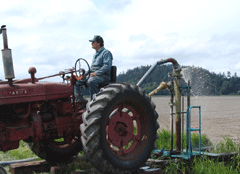
Alan Mesman, an organic dairy farmer, prepares to flood one of his fields. (Photo: Kevin Morse)
WANG: In the 1800’s, the settlers built dikes here, and drained the marshes along the Skagit River. What was left was a fine alluvial soil that’s been great for farming. But what was lost were tens of thousands of acres of wetlands. That was a blow to numerous species of wildlife, including shorebirds.
MORSE: The shorebirds are migratory, they fly from South and Central America all the way up to northern Canada, the Arctic, and historically they had lots of good places to stop and feed.
WANG: Kevin Morse is with the environmental group The Nature Conservancy. He says the loss of habitat all along the West Coast has led to a decline in 14 species of shorebirds. That’s a difficult problem to solve in areas that are heavily developed.

The Nature Conservancy’s Kevin Morse with Skagit County “Farmers for Wildlife” observe natural flooding of the Skagit River. (Photo: Kirsten Morse)
MORSE: Historically there was a patchwork of freshwater wetlands here, now we don’t have it, and now we have to be innovative and figure out how can we create that environment in the context of what is happening here.
WANG: So, The Nature Conservancy devised an elaborate experiment to see whether farmers could help bring shorebirds back. They guessed that even small pieces of wetlands scattered around the Skagit Delta could have a big impact. So they began looking for farmers who’d be willing to create new wetlands by flooding a portion of their land. They would compare the flooded fields with land that is grazed and land that is left alone.
The Nature Conservancy sweetened the deal by offering to pay rent for the land. And, at the end of the three year project, it would be chemical free and eligible for organic certification. Three farmers agreed to become the project’s guinea pigs, including dairy farmer Alan Messman.

Hedlin Farm Field being flooded. (Photo: Kevin Morse)
[GAS PUMP STARTING]
Now Messman is doing something previously unimaginable, he’s purposely flooding his fields. A makeshift pump draws fresh water from an irrigation ditch it spurts out from a pipe onto the dry ground. Scientists think that flooding will not only attract birds, but could make the soil more fertile as well. Messman isn’t so sure and the whole process makes him slightly uncomfortable.
MESSMAN: It seems odd to be pumping water on a field, you know when we spend our whole life pumping water off the fields. So, yeah, it’s different.
JONES: And in this close-knit farming community, there are skeptics. Farmers here have long been suspicious of conservationists. The two groups have fought bitterly over salmon restoration and other land use issues. Serena Campbell and her husband Dave sit at a picnic table by their century-old farmhouse. A dike behind them keeps the waters at bay. Campbell says they decided to join the project to prove that farming and conservation could coexist.
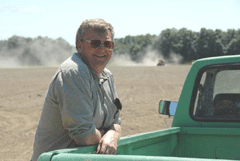
Dave Hedlin at the Thein Field during seeding (Photo: Kirsten Morse)
CAMPBELL: You have to kind of make a template that works, and part of that working is making the economics of it work, and once that’s in place, other people in community kind of lose their fear of what’s happened. We haven’t died doing this, and there weren’t any unexpected boogeymen.
JONES: If enough farmers lose their fear, the goal is to create a rotating patchwork of quality habitat for migrating shorebirds.
[BIRD AMBIENCE]
JONES: And if they are lucky, it could end up looking something like this. A few miles from the Skagit Delta sits a former potato field on the edge of a beautiful bay. The Nature Conservancy purchased the property in 2001, and then turned off the pump that kept the field dry.
Program Director Bob Carey says he was amazed by how quickly the wetlands returned.
KERRY: Within literally months, we saw shorebirds and waterfowl starting to show up here. Within a couple years, pretty spectacular diversity.
JONES: Now, Wilson’s phalaropes, dunlin and other shorebirds are frequent visitors along with snow geese, wood ducks, and great blue herons.
BIRD WATCHER: Moving left to right… there she goes.
JONES: And it may not take long for the shorebirds to return to the Skagit Delta either. Scientists there will be watching when the shorebirds pass through on their annual migrations at the end of the summer.
For living on earth, I’m Deborah Wang on Port Susan Bay, Washington.
Related links:
- Nature Conservancy “Farming for Wildlife” Homepage
- Skagitonians to Preserve Farmland, a farmers’ conservation group
- Seattle Times Travel piece on the Skagit River Delta
Plastic, Plastic Everywhere
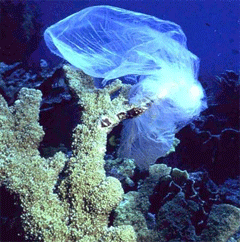
That’s not a jellyfish. It’s a plastic bag, the type that turtles often mistake for food. (Courtesy of NOAA)
CURWOOD: A decade or so ago Charles Moore veered off course in a sailing race from California to Hawaii and found himself in a windless area called the North Pacific Gyre. Nearly everywhere he looked was floating plastic. In fact, so much plastic has accumulated there that it covers an area more than twice the size of Texas. The encounter inspired Captain Moore to found the Algalita Marine Research Foundation to study the effects of plastic on the ocean. He says it’s the large pieces of plastic trash that have gotten the most attention, but he’s increasingly concerned about the smaller stuff that’s not so obvious. Captain Moore recently spoke with Living on Earth’s Ingrid Lobet.
LOBET: Captain Moore, we’ve all heard about plastic trash winding up in the ocean, but now it turns out that if a scientist scoops up a handful of sand or seawater just about anywhere and looks through a microscope he or she actually sees plastic. How can that be?
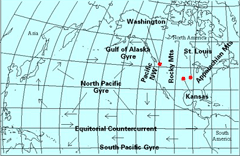
Map of the North Pacific Gyre, a region of the Pacific where multiple currents come together and trap garbage that blows off land. (Courtesy of USGS.)
MOORE: Plastic does not biodegrade. It’s what we call bio-inert. So what happens is plastic becomes enbrittled, it ages through a series of processes instigated by ultraviolet light from the sun. And that degradation results in cracking and weakening of the tensile strength of the plastic, but it doesn’t result it its becoming carbon dioxide and water like a piece of wood would or a piece of food scrap.
LOBET: But the amount, we’ve actually changed the composition to the degree that any random sample that you look at under the microscope is now no longer mostly natural material?
MOORE: As a matter of fact, in coastal studies off Southern California and in studies as far from the coast as you can get, half way between Los Angeles and Hawaii, we found that in the surface, plastic outweighs plankton. And the coastal ocean even has more plastic than plankton near the bottom. We’ve done tows with what we call an epibenthic sled that pulls a net just above the floor of the ocean off of Southern California and in those studies as well we found more plastic than plankton.
LOBET: And what is the main pathway? How has this much plastic made its way into the ocean?
MOORE: I think it’s all of us and our product and food delivery system, which is largely plastic. Trash receptacles are not always available. It’s very lightweight and it blows and washes into the sea.
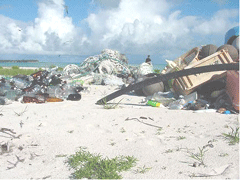
Piles of plastic garbage were collected in one morning on Easter Island. (Photo: B. Mayer/U.S. Fish and Wildlife Service)
MOORE: Well, because the main life cycle, the main activity that goes on in the ocean happens at what we call the base of the marine food web in filter feeding organisms. And if molecular sized bits of plastic are floating around there, they’re going to filter them out. And the fish, and birds, and dolphins, and whales and turtles, these larger creatures are feeding off of creatures, which have consumed this plastic material. So we’re concerned because this plastic material has been demonstrated to act as a sponge for pollutants. And thereby transfer them into this marine food web.
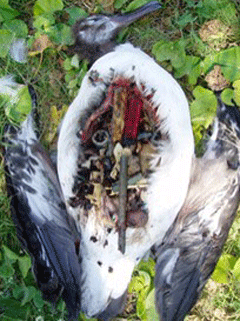
This albatross chick died with 306 pieces of plastic in its belly. Some of them up to 6 inches long and jagged. (Photo: Claire Johnson/NOAA)
LOBET: As far as their appearance do these plastic shards and pieces, do they mimic food for sea animals?
MOORE: I’ve often said that there’s no food in the ocean that plastic can’t mimic. Just as plastic is infinitely moldable, the way it breaks down in the ocean is infinitely variable. We have very large objects of plastic in the ocean and we have very small objects of plastic in the ocean. And they assume virtually every shape, consistency, and color. Actually we think color is a very important component of consumption by creatures that selectively take prey. In birds stomachs we find mostly red bottle caps, red cigarette lighters. Then there’s the issue of what the turtles eat. The turtles each jellyfish, which are pretty transparent and their consistency is fairly watery which a plastic bag can mimic very well. So, they’re easily confused and it’s well known that turtles are eating large quantities of plastic bags.
LOBET: There is this development that researchers are taking about bioplastics, or making plastic-like material from vegetable matter. How much of a solution is that to the problem of plastics in the ocean?

That’s not a jellyfish. It’s a plastic bag, the type that turtles often mistake for food. (Courtesy of NOAA)
LOBET: What should government be doing and what else should individuals be doing?
MOORE: Well, government has to what I refer to as kick start the infrastructure. We have to have take back programs. I mean 27 percent of the total of what we found out in the North Pacific Gyre was thin plastic films like is used in packaging. That material has virtually no take back. No code has to be printed on it so that you know what kind it is. And there’s no infrastructure for taking it back and reusing it. Individuals need to bring their own bag, they need to bring their own cup. They need to make choices about the products that they buy and look for things that aren’t wrapped in plastic. I consider to be an irony that a product that lasts forever is used for seconds and tossed.
LOBET: Well, thanks so much for talking with us.
MOORE: You’re welcome. Thank you for the interview.
[Fridge "Insects" from ‘The Sun’ (Temporary Residence -2007)]
CURWOOD: Captain Charles Moore of the Algalita Marine Research Foundation, speaking with Living on Earth’s Ingrid Lobet.
Related link:
Algalita Marine Research Foundation
Hoo’s Calling

MIT professor Dale Joachim tracks Great Horned Owls (Courtesy of U.S. Bureau of Reclamation)
CURWOOD: Some folks claim they can communicate with animals. And now, an electrical engineering professor at MIT is taking it one step further—he calls owls on his cell phone. Willie D. Jones of IEEE Spectrum went out into the field in Central Connecticut with this modern-day Dr. Doolittle to see if he had hit upon something worth hooting about.
[SOUNDS OF FOOTSTEPS]
JONES: On a cold, quiet night, a group of well-bundled souls trudges out to the end of a desolate dirt road. They stop between two stands of trees and quickly set up several tripods. Some are mounted with cell phones attached to loudspeakers, others have cell phones with receivers and recording equipment. MIT professor Dale Joachim heads this team. In the still of the night, he whispers the point of this excursion.
JOACHIM: To demonstrate that the owls respond to cell phone quality audio.
JONES: Joachim believes his innovation will help researchers and conservationists track and keep a fairly accurate count of animals—without repeatedly disturbing their habitats.

Cellphone device used to attract owls (Courtesy of Dale Joachim)
He taps the touch screen of his cell phone.
[SOUND OF TAPPING]
The handset controls a Web site housed in his office on the MIT campus. It lets him choose which of the loudspeakers will emit the series of whistles and chirps that faithfully replicate the birds’ calls. In this case, screech owls. He can also choose which receivers will listen for any responding bird-calls and record them. He uses multiple phones to get a better sense of the direction the sound is coming from.
JOACHIM: The idea is that in the future we can leave these things out in the forest and set them out with a little battery that will keep recharging the phone and keep it there for long periods of time.
JONES: And initiate contact with birds from anywhere in the world. Joachim hit upon the idea while talking to an ornithologist at the Audubon Zoo in New Orleans. The bird researcher described the preferred method of monitoring bird populations: sending a trained person to the critters’ habitat to actually count them. Joachim thought there had to be a better way.
JOACHIM: I suggested to her that we should probably automate this process. And the most interactive channel I could think about was the cell phone.
JONES: This automated tracking, he says, will allow humans to use birds and other animals as sensors.

MIT professor Dale Joachim tracks Great Horned Owls(Courtesy of U.S. Bureau of Reclamation)
JONES: Joachim himself could have used such a heads-up. When Hurricane Katrina struck southern Louisiana and Mississippi, he was at Tulane University, in New Orleans. In the aftermath of the storm, he and his graduate students scattered to schools across the United States, and the bulk of their work on the bird-monitoring project was destroyed.
JOACHIM: Certain species of birds and many animals left the New Orleans area before the hurricane came. And I think it’s worth looking into. In the sense that birds may have had advance warning, and hopefully they vocalized upon this warning. If we can learn something about the sort of sound, or the sort of changes in vocalization that happens when they have this sort of warning, we may be able to also have a second line of defense before something hits.

MIT Professor Dale Joachim (Photo: www.dalsimerphoto.com)
JONES: Suddenly, the field loudspeaker lets off its first chorus of pre-recorded owl calls.
[DIGITAL SCREECH OWL]
JONES: There we were at the moment of truth. Would any birds respond? I had my doubts. But then, there it was, softly in the distance:
[CALL AND RESPONSE]
JONES: A sustained period of call and response reminiscent of a soloist and a church congregation. The back-and-forth continued until another bird’s call caused one of the screech owls to clam up and take flight.
JOACHIM: They responded, but didn’t come close enough for us to take a picture or anything of the sort.
JONES: The MIT professor and his team, having made contact with birds at three woodland locations over the course of four hours, call it a night. During the next few months, they’ll refine the calling system in preparation for setting up a large bird-monitoring network. When Dale Joachim does finally get his equipment set up in forests around the world, it will give a new definition to the term “chat room.” For Living on Earth, I’m Willie D. Jones in Central Connecticut.
CURWOOD: That story comes to us courtesy of IEEE Spectrum magazine.
[“Eastern Screech-Owl” recorded by Lang Elliott for ‘A Guide To Night Sounds’ (Nature Sound Studio – 1992)]
Related links:
- IEEE Spectrum story on Dale Joachim's project
- MIT Media Lab's Owl Project
CURWOOD: You might say the Eastern Screech Owl lives up to its name with its range of calls, including the whinny. Lang Elliott of Nature Sound Studios recorded these wise-beyond-their-ears sounds.
CURWOOD: Living on Earth is produced by the World Media Foundation. Our crew includes Ashley Ahearn, Eileen Bolinsky, Bruce Gellerman, Ian Gray, Ingrid Lobet, Andrea Smardon, Peter Thomson and Jeff Young - with help from Bobby Bascomb, and Kelley Cronin. Our interns are Lauren Cox and Amy Fish.
Dennis Foley is our technical director. Alison Lirish Dean composed our themes. You can find us anytime at LOE dot org. I’m Steve Curwood. From all of us here at Living on Earth, thanks for listening.
ANNOUNCER: Funding for Living on Earth comes from the National Science Foundation, supporting coverage of emerging science; and Stonyfield Farm Organic yogurt and smoothies. Stonyfield pays its farmers not to use artificial growth hormones on their cows. Details at Stonyfield dot com.
Support also comes from you our listeners, the Ford Foundation, the Wellborn Ecology Fund and Pax World Mutual Funds—socially and environmentally sustainable investing. Pax World, for tomorrow. On the Web at paxworld dot com.
Living on Earth wants to hear from you!
Living on Earth
62 Calef Highway, Suite 212
Lee, NH 03861
Telephone: 617-287-4121
E-mail: comments@loe.org
Newsletter [Click here]
Donate to Living on Earth!
Living on Earth is an independent media program and relies entirely on contributions from listeners and institutions supporting public service. Please donate now to preserve an independent environmental voice.
NewsletterLiving on Earth offers a weekly delivery of the show's rundown to your mailbox. Sign up for our newsletter today!
 Sailors For The Sea: Be the change you want to sea.
Sailors For The Sea: Be the change you want to sea.
 The Grantham Foundation for the Protection of the Environment: Committed to protecting and improving the health of the global environment.
The Grantham Foundation for the Protection of the Environment: Committed to protecting and improving the health of the global environment.
 Contribute to Living on Earth and receive, as our gift to you, an archival print of one of Mark Seth Lender's extraordinary wildlife photographs. Follow the link to see Mark's current collection of photographs.
Contribute to Living on Earth and receive, as our gift to you, an archival print of one of Mark Seth Lender's extraordinary wildlife photographs. Follow the link to see Mark's current collection of photographs.
 Buy a signed copy of Mark Seth Lender's book Smeagull the Seagull & support Living on Earth
Buy a signed copy of Mark Seth Lender's book Smeagull the Seagull & support Living on Earth

